Experimental Study on the Behaviour of Seismic Actions on a Flexible Glass-Reinforced Plastic Structure Used in Water Transport Pipes
Abstract
1. Introduction
1.1. Background
- -
- the damage of pipes occurs due to crossover breaks, breaks in the rough joint area, breaks in the stiffening areas (manholes, building foundations etc.);
- -
- most of the damages were on the pipes where the route coincided with the dispersion direction of seismic waves, registering damages such as: tearing the ends of pipes from the sockets, destruction of joint parts and crossing cracks;
- -
- the pipes with expansion buffers in the connection points to the rough constructions are more resistant to seismic stresses.
1.2. Current State of Research
1.3. Theoretical Considerations Regarding the GRP Pipeline
1.4. Theoretical Considerations Regarding the Seismic Actions
1.5. Scope and Contributions of the Paper
2. Experimental Design and Method Used
3. Results and Discussion
4. Results Validation
4.1. Validation of the Results in a Theoretical Manner
4.2. Validation of the Results through the Finite Element Method
5. Conclusions
Author Contributions
Funding
Institutional Review Board Statement
Informed Consent Statement
Acknowledgments
Conflicts of Interest
References
- Funari, M.F.; Verre, S. The Effectiveness of the DIC as a Measurement System in SRG Shear Strengthened Reinforced Concrete Beams. Crystals 2021, 11, 265. [Google Scholar] [CrossRef]
- Fortunato, G.; Funari, M.F.; Lonetti, P. Survey and seismic vulnerability assessement of the baptisery of San Giovanni in Tumba (Italy). J. Cult. Herit. 2017, 26, 64–78. [Google Scholar] [CrossRef]
- Simão, M.; Mora-Rodriguez, J.; Ramos, H.M. Design Criteria for Suspended Pipelines Based on Structural Analysis. Water 2016, 8, 256. [Google Scholar] [CrossRef]
- Shin, S.; Lee, S.; Judi, D.R.; Parvania, M.; Goharian, E.; McPherson, T.; Burian, S.J. A Systematic Review of Quantitative Resilience Measures for Water Infrastructure Systems. Water 2018, 10, 164. [Google Scholar] [CrossRef]
- ASRO (Asociația de Standardizare din România). SR EN 1998-4:2007 Eurocode 8. In Proiectarea Structurilor Pentru Rezistenta la Cutremur. Partea 1–3 (Design of Structures for Earthquake Resistance. Part 1–3); ASRO: Bucharest, Romania, 2007. [Google Scholar]
- Furis, D.; Teodorescu, M.E.; Sorohan, L. Calculul Structurilor Pentru Transportul Apei (Calculation of Structures for Water Transport); Conspress: Bucharest, Romania, 2012. [Google Scholar]
- Mamzumder, R.K.; Asce, S.M.; Salman, A.M.; Asce, A.M.; Li, Y.; Xiong, Y. Performance Evaluation of Water Distribution Systems and Asset Management. J. Infrastruct. Syst. 2018, 24. [Google Scholar] [CrossRef]
- Kaushal, V.; Najafi, M.; Serajiantehrani, R. Environmental Impacts of Conventional Open-Cut Installation and Trenchless Technology Methods: State of the Art Review. J. Pipeline Syst. Eng. Pract. 2020, 11. [Google Scholar] [CrossRef]
- Bruneau, M.; Chang, S.E.; Eguchi, R.T.; Lee, G.C.; O’Rourke, T.D.; Reinhorn, A.M.; Shinozuka, M.; Tierney, K.; Wallace, W.A.; Winterfeldt, D. A Framework to Quantitatively Assess and Enhance the Seismic Resilience of Communities. Earthq. Spectra 2003, 19, 733–752. [Google Scholar] [CrossRef]
- Alzabeebee, S.; Chapman, D.; Jefferson, I.; Faramarzi, A. The response of buried pipes to UK standard traffic loading. Proc. Inst. Civ. Eng. Geotech. Eng. 2017, 170, 38–50. [Google Scholar] [CrossRef]
- Amarasinghe, P.; Liu, A.; Egodawatta, P.; Barnes, P.; McGree, J.; Goonetilleke, A. Quantitative assessment of resilience of a water supply system under rainfall reduction due to climate change. J. Hydrol. 2016, 540, 1043–1052. [Google Scholar] [CrossRef]
- Asprone, D.; Manfredi, G. Seismic Resilience. In Encyclopedia of Earthquake Engineering; Springer: Berlin/Heidelberg, Germany, 2015. [Google Scholar]
- Lengnick-Hall, L.A.; Beck, T.E.; Lengnick-Hall, M. Developing a capacity for organizational resilience through strategic human resource management. Hum. Resour. Manag. Rev. 2011, 21, 243–255. [Google Scholar] [CrossRef]
- Bunea, G.; Atanasiu, G.M. Overview of Romania’s Seismicity Focusing at Country and Regional Level. In Proceedings of the First Split Workshop at the Technical University “Gheorghe Asachi” of Iasi, ERA Net FP7—Concert Japan, Road Networks for Earthquake Resilient Societies—Roaders Project, ctr. 3003/2013; “Gheorghe Asachi” Technical University of Iaş: Iași, Romania, 2017; pp. 29–53. [Google Scholar]
- Ancas, A.D.; Profire, M. Seismic Safety Evaluation of the Pipelines Network. J. Appl. Eng. Sci. 2017, 7, 7–10. [Google Scholar] [CrossRef]
- Toparak, S.; Taskin, F. Estimation of Earthquake Damage to Buried Pipelines Caused by Ground Shaking. Nat. Hazards 2007, 40, 1–24. [Google Scholar] [CrossRef]
- Abdoun, T.H.; Da, H.; O’Rorke, M.J.; Symans, M.D. Factors influencing the behavior of buried pipeline subjected to earthquake faulting. Soil Dyn. Earthq. Eng. 2009, 29, 415–427. [Google Scholar] [CrossRef]
- Rakitin, B.; Xu, M. Centrifuge modeling of large-diameter underground pipes subjected to heavy traffic loads. Can. Geotech. J. 2014, 51, 353–368. [Google Scholar] [CrossRef]
- Așchilean, I.; Iliescu, M.; Ciont, N.; Giurca, I. The Unfavourable Impact of Street Traffic on Water Distribution Pipelines. Water 2018, 10, 1086. [Google Scholar] [CrossRef]
- European Commission, Directorate General Transport. COST 333. Development of New Bituminous Pavement Design Method. Final Report of the Action; Office for Official Publications of the European Communities: Luxembourg, 1999; pp. 173–184. [Google Scholar]
- ASRO (Asociația de Standardizare din România). SR EN 1998-5:2004 Eurocode 8. In Proiectarea Structurilor Pentru Rezistenta la Cutremur. Partea 5: Fundatii, Structure de Sustinere si Aspect Geometrice, [Design of Structures for Earthquake Resistance. Part 5: Foundations, Retaining Structures and Geometric Aspect]; ASRO: Bucharest, Romania, 2004. [Google Scholar]
- Unified Facilities Criteria. Structures to Resist the Effects of Accidental Explosions; UFC 3-340-02 Department of Defense; U.S. Army Corps of Engineers, Naval Facilities Engineering Command, Air Force Civil Engineer Support Agency: San Antonio, TX, USA, 2009. [Google Scholar]
- Ancaș, A.; Profire, M.; Verdeș, M.; Ciocan, V. Dynamic analysis of the seismic action of underground structure to water transport. Rev. Romana Ing. Civ. 2017, 8, 238–242. [Google Scholar]
- Van Zyl, J.E. Introduction to Operation and Maintenance of Water Distribution Systems, 1st ed.; Water Research Commission: Tshwane, South Africa, 2014; pp. 61–69. Available online: https://www.pseau.org/outils/ouvrages/wrc_introduction_to_operation_and_maintenance_of_water_distribution_systems_2014.pdf (accessed on 25 May 2021).
- Ancaș, A.D.; Atanasiu, G.M. Seismic Risk Management considering the Urban Lifeline Existing System. Bus. Excell. 2011, I, 20–23. [Google Scholar]
- Reis, P.; Neto, M.A.; Amaro, A. Effect of hostile solutions on stress relaxation of carbon/epoxy composites. Polym. Degrad. Stab. 2019, 165, 60–67. [Google Scholar] [CrossRef]
- Shantanu, J.; Prashant, A.; Deb, A.; Jain, S.K. Analysis of buried pipeline subjected to reverse fault motion. Soil Dyn. Earthq. Eng. 2011, 31, 930–940. [Google Scholar]
- Ancas, A.D.; Profire, M. The Effeects of pH Soil on Mechanical Properties of GRP Pipes. Environ. Eng. Manag. J. 2018, 17, 1879–1885. [Google Scholar] [CrossRef]
- Ancas, A.D.; Cîrstolovean, I.L.; Profire, M. Influence of Soil Pollution on Glass Reinforced Plastic Water Pipes. J. Environ. Prot. Ecol. 2018, 19, 721–726. [Google Scholar]
- Kubo, K. Behavior of Underground Waterpipes During an Earthquake. In Proceedings of the 5th Word Conference on Earthquake Engineering 2003, Rome, Italy, 12–14 September 2003; pp. 569–578. [Google Scholar]
- Chaallal, O.; Arockiasamy, M.; Godat, A. Field Test Performance of Buried Flexible Pipes under Live Truck Loads. J. Perform. Constr. Facil. 2014, 29, 04014124. [Google Scholar] [CrossRef]
- European Standard. EN 10224:2002 Tubes for the Conveyance of Water and Other Aqueous Liquids. Technical Delivery Conditions; European Standardisation Organisations: Brussels, Belgium, 2002. [Google Scholar]
- Aşchilean, I. Reabilitarea şi modernizarea sistemelor de alimentare cu apă a localităţilor urbane. In Rehabilitation and Modernization of Water Supply Systems in Urban Areas; Risoprint: Cluj-Napoca, Romania, 2014. [Google Scholar]
- Ghid Privind Reabilitarea Conductelor Pentru Transportul Apei. Indicativ GP 127-2014; Guidelines on the Rehabilitation of Pipes Used for Water Distribution. Code GP 127-2014; Ministerul Dezvoltării Regionale și Administrației Publice: Bucharest, Romania, 2014; pp. 13–18. Available online: https://www.mlpda.ro/userfiles/reglementari/Domeniul_XIII/13_18_GP_127_2015.pdf (accessed on 26 May 2021).
- Moser, A.P. Buried Pipe Design, 2nd ed.; McGraw Hill: New York, NY, USA, 2001. [Google Scholar]
- Felseghi, R.A.; Iacob, C.; Bolboacă, A.; Deac, A.; Plesa, F. Materials used in the rehabilitation and modernization of urban utility networks. Mod. Sci. Energy 2020, 39, 166–173. [Google Scholar]
- Ancas, A.D.; Profire, M.; Cojocaru, G. Experimental Evaluation a Tensile Strength of PAFSIN Pipes in Different Types of Land. J. Appl. Eng. Sci. 2017, 7, 11–16. [Google Scholar] [CrossRef]
- Samba, C.; Baldeh, M.; Tuffour, K. Analysis of Water Pipeline Breaks. World J. Eng. Technol. 2016, 04, 220–227. [Google Scholar] [CrossRef][Green Version]
- Rajeev, P.; Kodikara, J.; Robert, D.; Zeman, P.; Rajani, B. Factors contributing to large diameter water pipe failure. Water Asset Manag. Int. 2014, 14, 9–14. [Google Scholar]
- O’Rourke, M.; Deyoe, E. Seismic Damage to Segmented Buried pipe. Earthq. Spectra 2004, 20, 1167–1183. [Google Scholar] [CrossRef]
- ASRO (Asociația de Standardizare din România). SR EN 1998-1:2004 Eurocode 8. In Proiectarea Structurilor Pentru Rezistenta la Cutremur. Partea 1: Reguli Generale, Actiuni Seismice Si Reguli Pentru Cladiri, (Design of Structures for Earthquake Resistance. Part 1: General Rules, Seismic Actions and Rules for Buildings); ASRO: Bucharest, Romania, 2004. [Google Scholar]
- Kawashima, K. Seismic Analysis of Underground Structures. J. Disaster Res. 2006, 1, 378–389. [Google Scholar] [CrossRef]
- Leon, F.; Atanasiu, G.M.; Bunea, G. Critical Assessment of Road Network Resilience Using an Agent-Based Evacuation Model. In Proceedings of the 7th Balkan Conference on Informatics Conference ACM, Craiova, Romania, 2–4 September 2015; Volume 21, pp. 1–8. [Google Scholar]
- Li, S.; Wang, R.; Wu, W.; Sun, J.; Jing, Y. Non-hydraulic Factors Analysis of Pipe Burst in Water Distribution Systems. Procedia Eng. 2015, 119, 53–62. [Google Scholar] [CrossRef]
- Marzouk, M.; Hamid, S.A.; El-Said, M. A methodology for prioritizing water mains rehabilitation in Egypt. HBRC J. 2015, 11, 114–128. [Google Scholar] [CrossRef]
- Mugume, S.; Diao, K.; Astaraie-Imani, M.; Fu, G.; Farmani, R.; Butler, D. Enhancing resilience in urban water systems for future cities. Water Supply 2015, 15, 1343–1352. [Google Scholar] [CrossRef][Green Version]
- Mohr, W. Strain Based Design Pipelines, 2nd ed.; McGraw Hill: New York, NY, USA, 2001. [Google Scholar]
- Hindy, A.; Novak, M. Earthquake response of underground pipelines. Earthq. Eng. Struct. Dyn. 1979, 7, 451–476. [Google Scholar] [CrossRef]
- Novak, M.; Hindy, A. Seismic Analysis of Underground Tubular Structures. Available online: http://www.iitk.ac.in/nicee/wcee/article/7_vol8_287.pdf (accessed on 25 May 2021).
- Ancaş, A.D.; Aşchilean, I.; Profire, M.; Toma, I. System for Increasing the Seismic Safety of Pipelines in the Water Supply and Distribution Networks. Water 2019, 11, 1049. [Google Scholar] [CrossRef]
- Xu, M.; Shen, D.; Rakitin, B. The longitudinal response of buried large-diameter reinforced concrete pipeline with gasketed bell-and-spigot joints subjected to traffic loading. Tunn. Undergr. Space Technol. 2017, 64, 117–132. [Google Scholar] [CrossRef]
- Watkins, K.R.; Anderson, R.L. Structural Mechanics of Buried Pipes; CRC Press: Boca Raton, FL, USA, 2000. [Google Scholar]
- CEC151CI/2018—Creating and Testing the Experimental Design of a Seismic Protection Assembly for Buried Water Transport Pipelines for its Implementation. Available online: http://www.rtmesa.tuiasi.ro/ (accessed on 16 March 2021).
- ASRO (Asociația de Standardizare din România). SR EN 1998-4:2007 Eurocode 8. In Proiectarea Structurilor Pentru Rezistenta la Cutremur. Partea 4: Silozuri, Rezervoare, Conducte, (Design of Structures for Earthquake Resistance. Part 4: Silos, Tanks, Pipe); ASRO: Bucharest, Romania, 2007. [Google Scholar]
- Multidisciplinary Center of Structural Engineering & Risk Management. Available online: https://erris.gov.ro/Centrul-multidisciplinar-Ing (accessed on 20 March 2021).
- Roman, M.D.; Felseghi, R.-A. Analysis of Oxygen Transfer and Dissolved Oxygen Concentration Measurement Tests in a Wastewater Treatment Plant. Appl. Mech. Mater. 2014, 656, 486–494. [Google Scholar] [CrossRef]
- Roman, M.D.; Felseghi, R.A.; Mureşan, M.V. Modelling and simulation of BOD and COD for effluent levels of an aeration tank from Gherla waste water treatment plant. Studia Univ. Babes-Bolyai Chemia 2015, 60, 399–408. [Google Scholar]
- ANSYS Fluent User’s Guide. Available online: http://www.pmt.usp.br/academic/martoran/notasmodelosgrad/ANSYS%20Fluent%20Users%20Guide.pdf (accessed on 11 October 2020).
- Software Manual Autodesk Robot Structural Analysis Professional 2011. Available online: https://knowledge.autodesk.com (accessed on 10 October 2020).

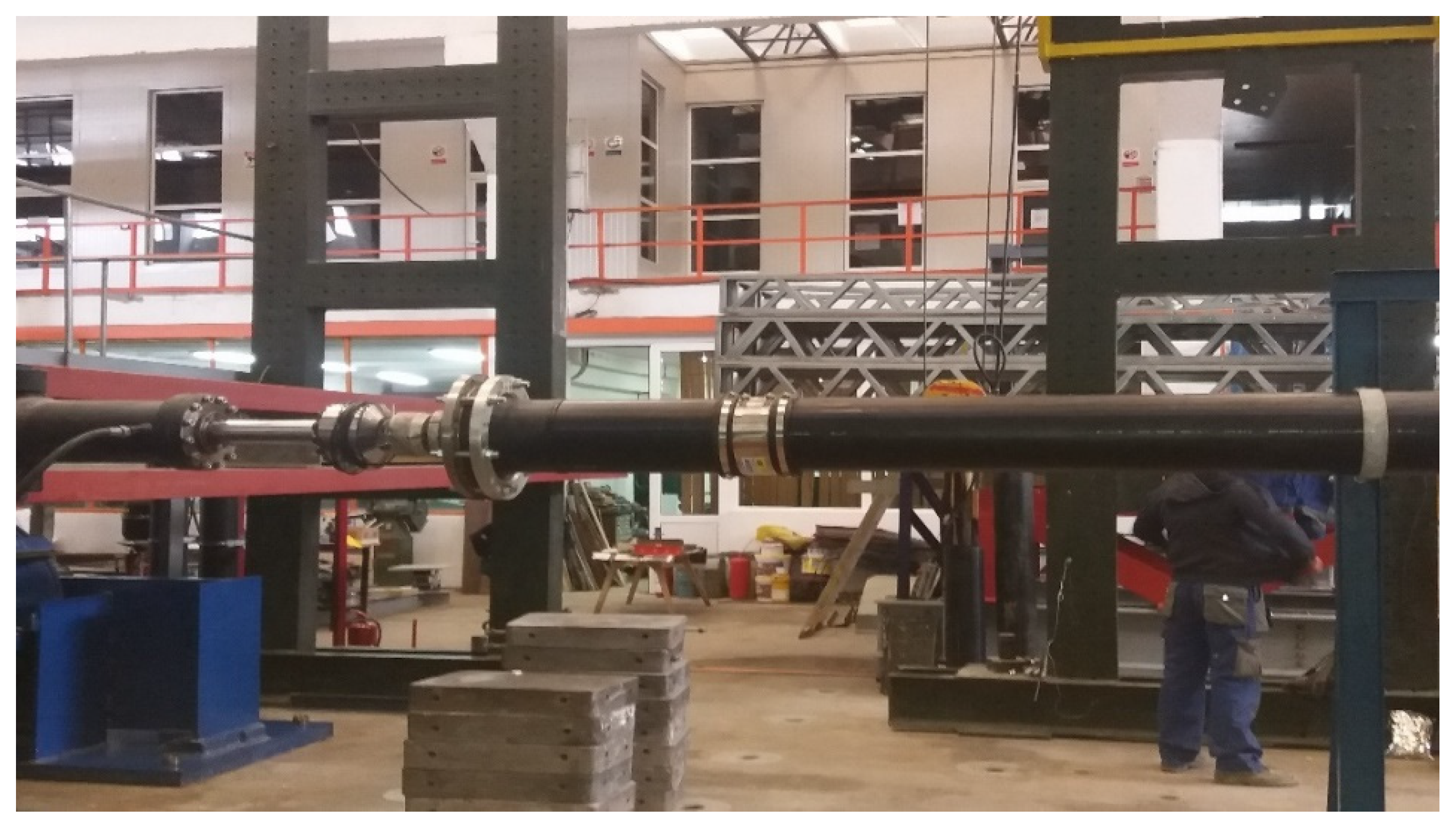
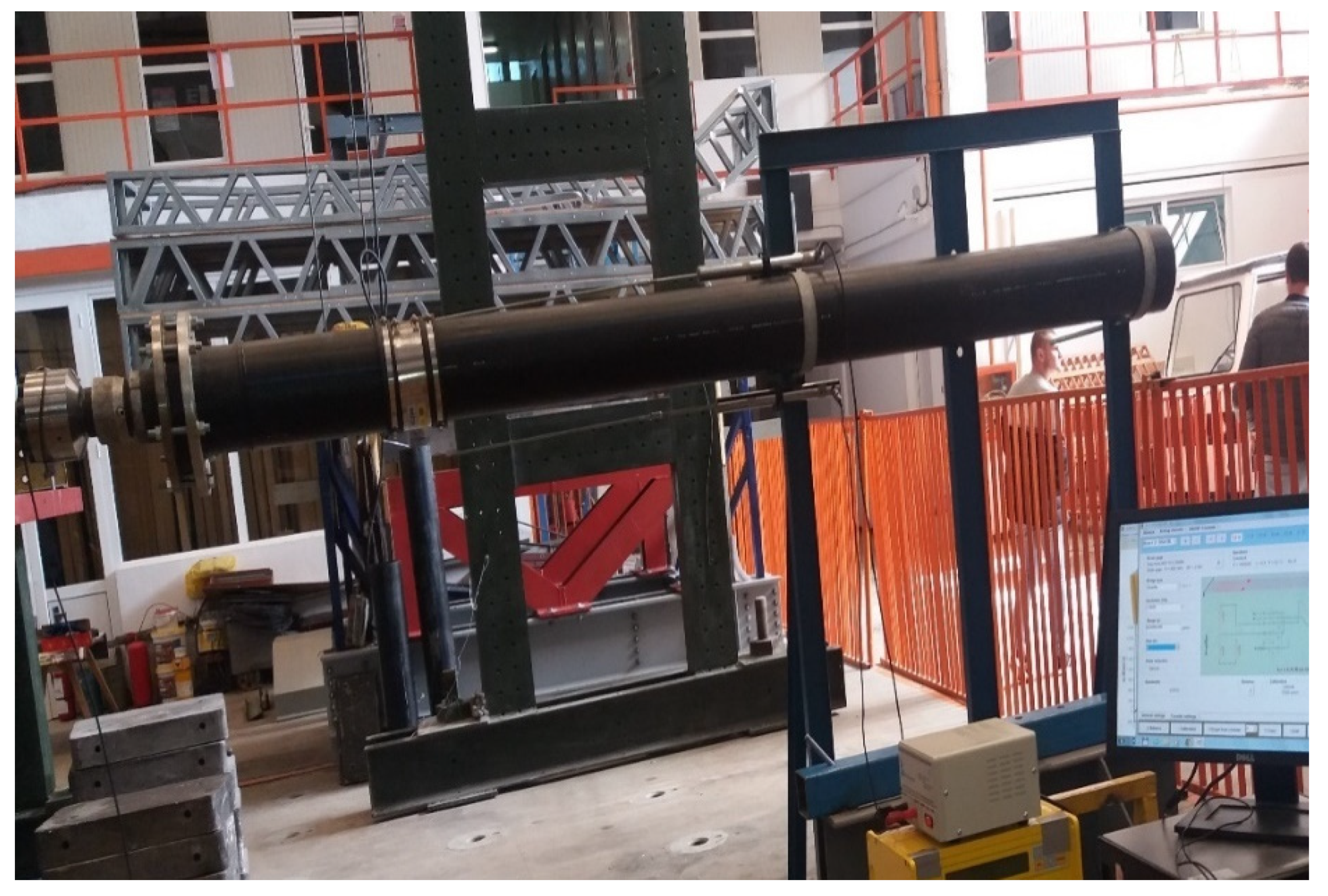
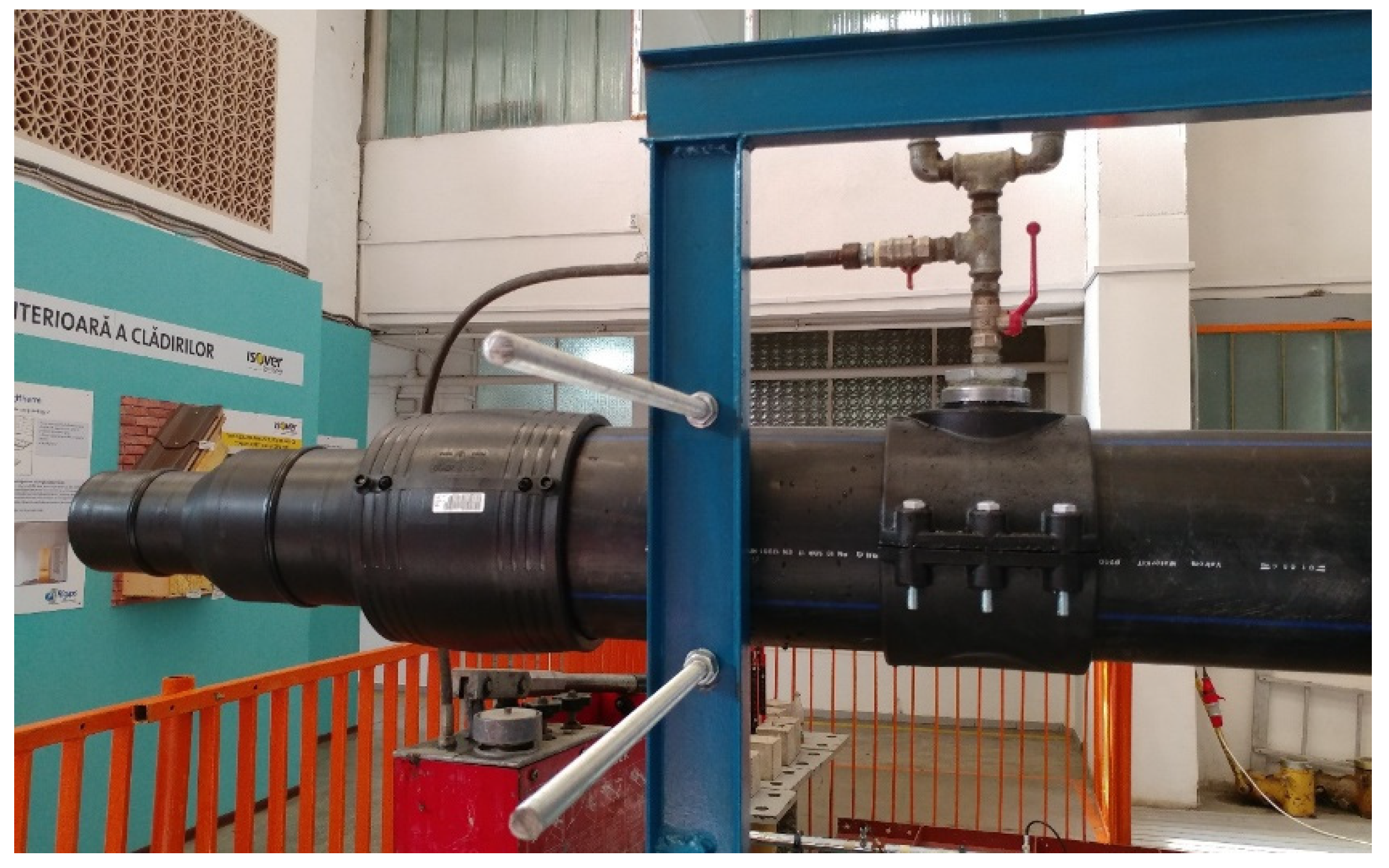
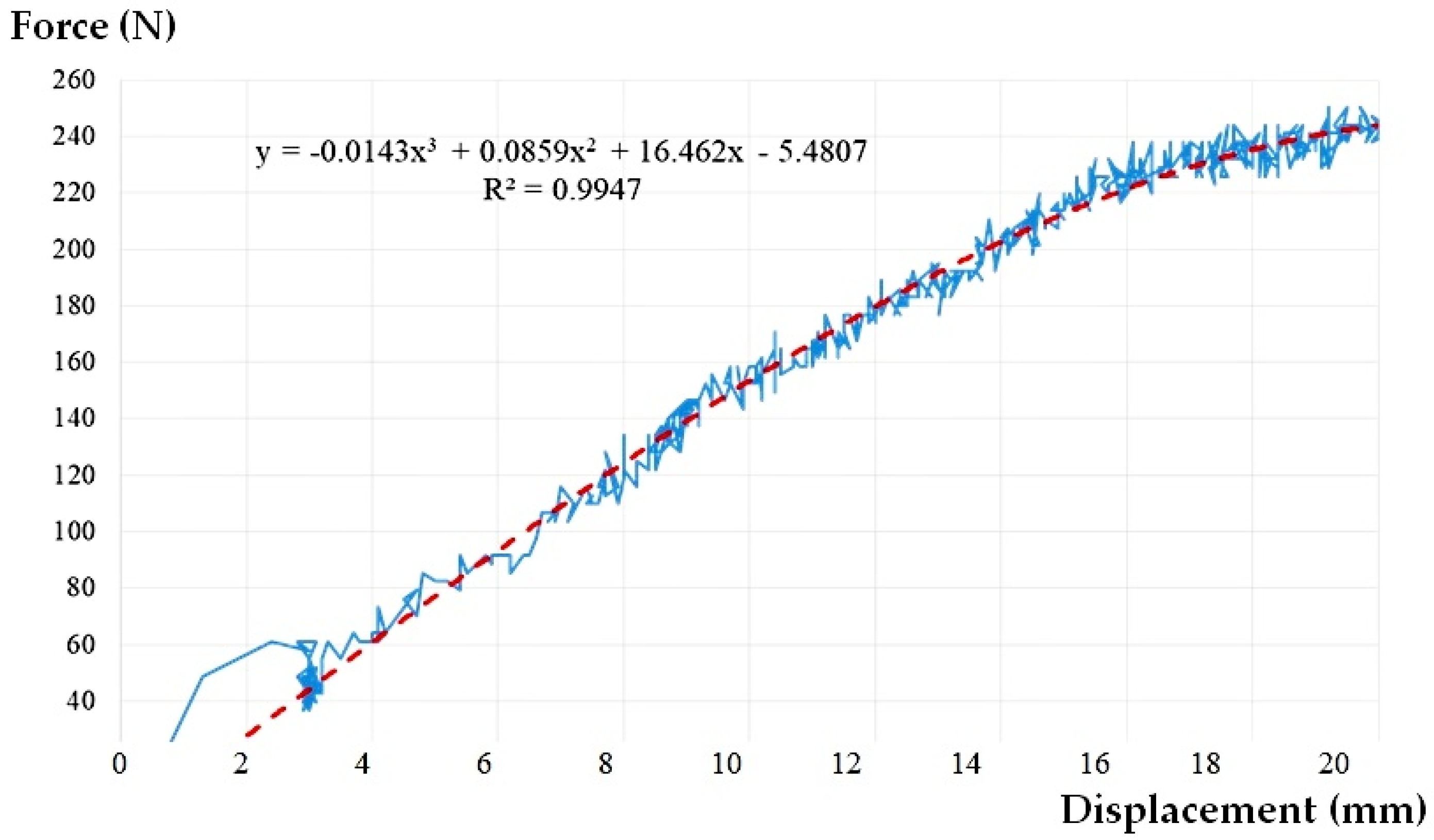
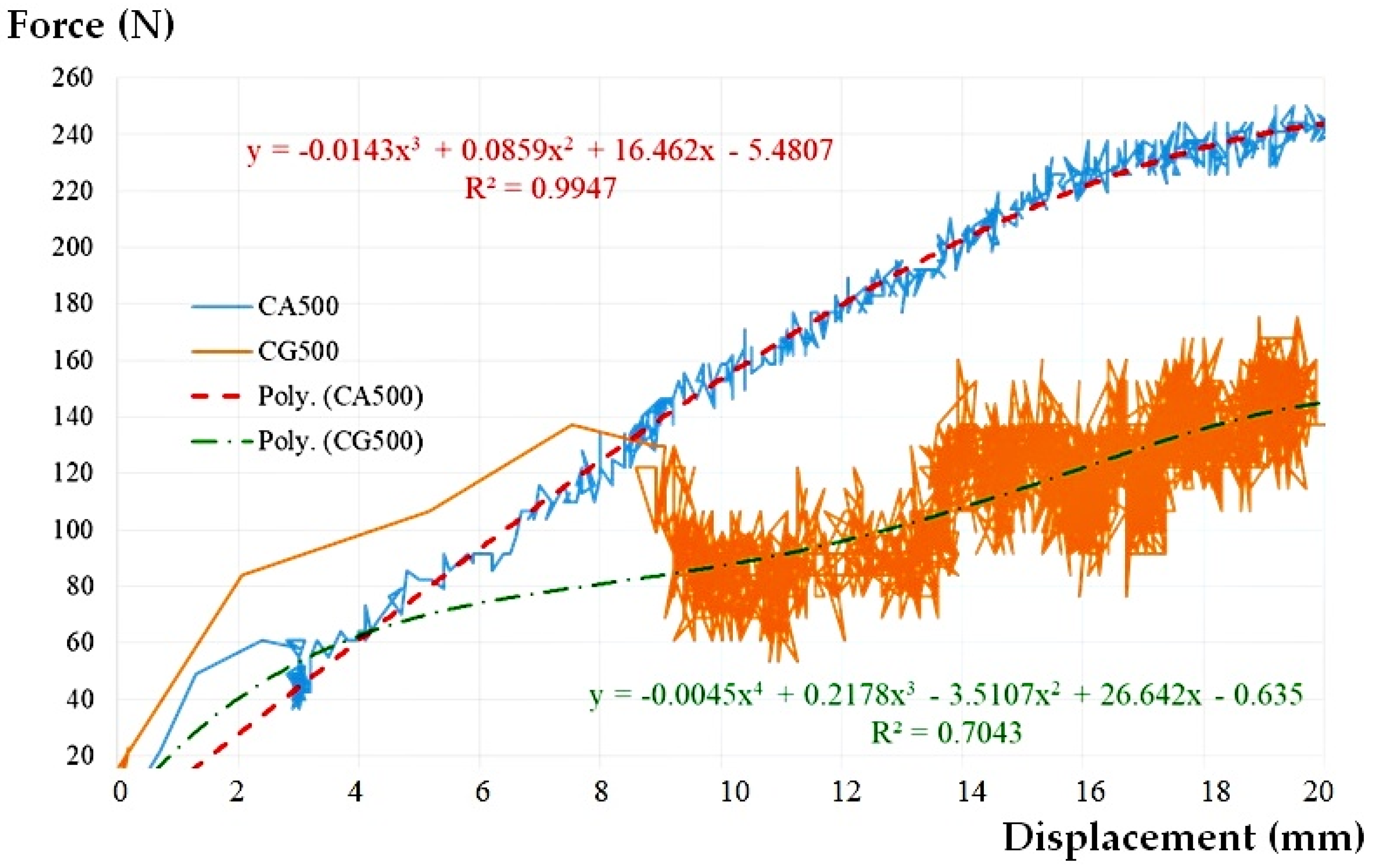
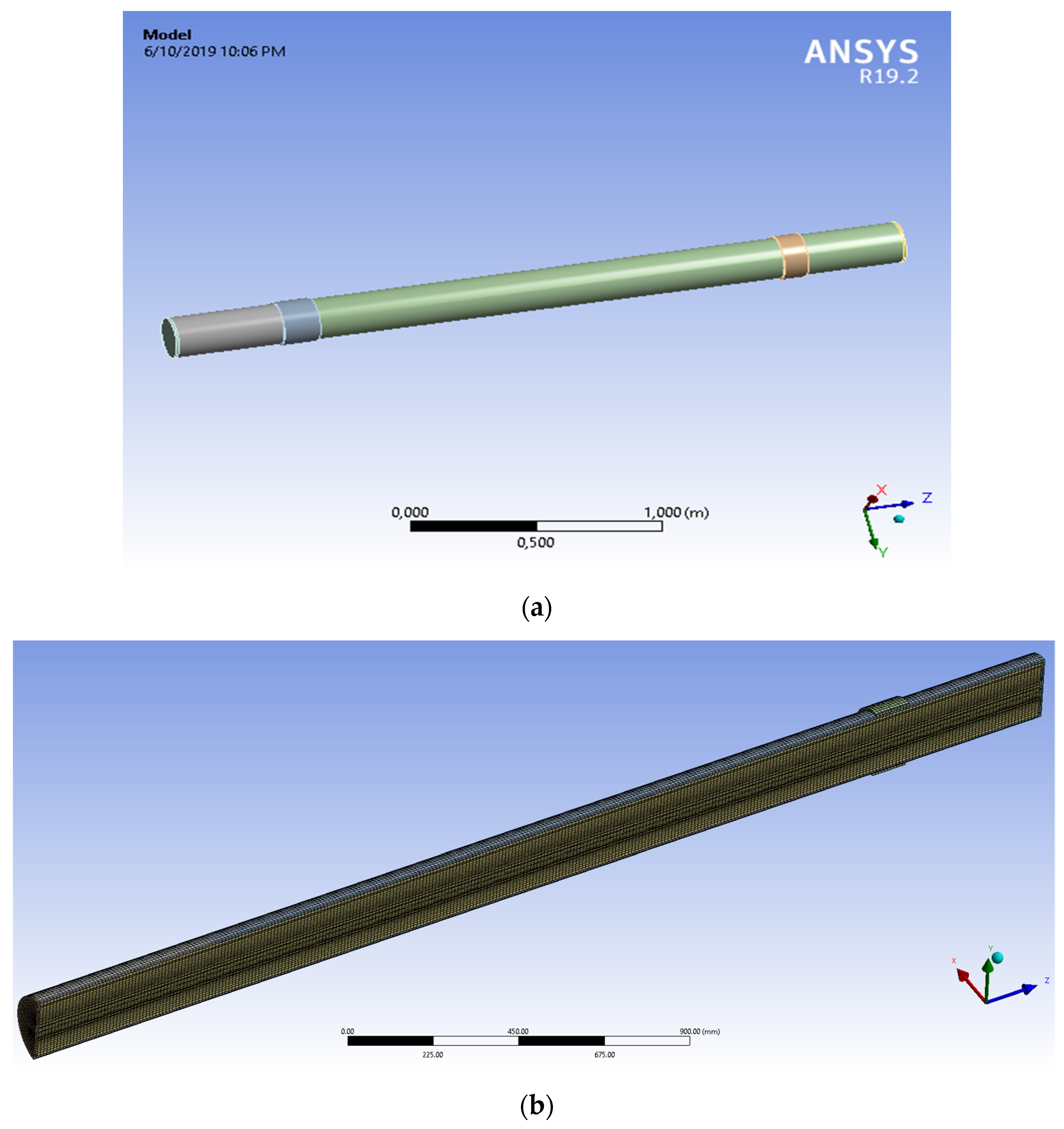

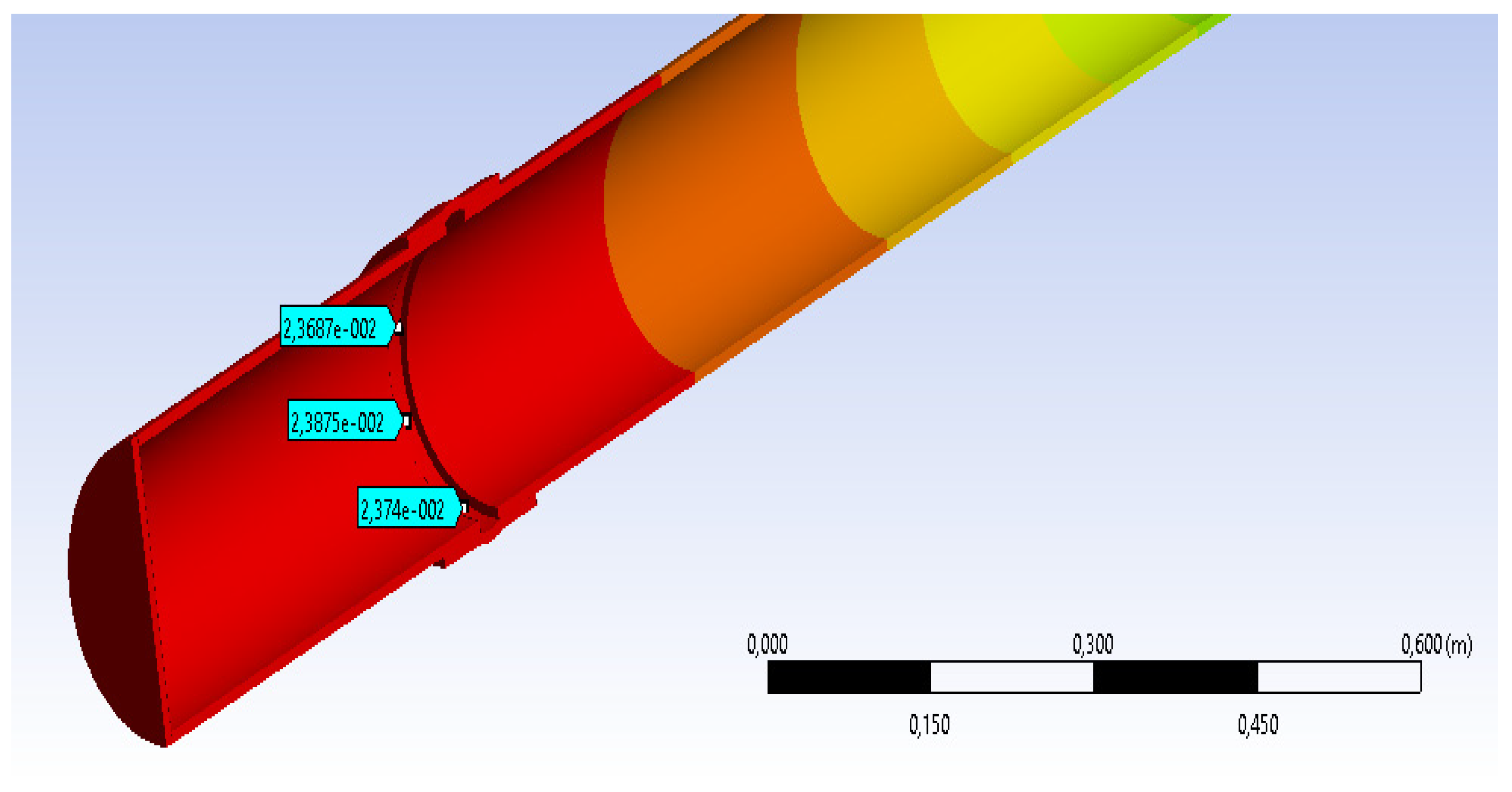
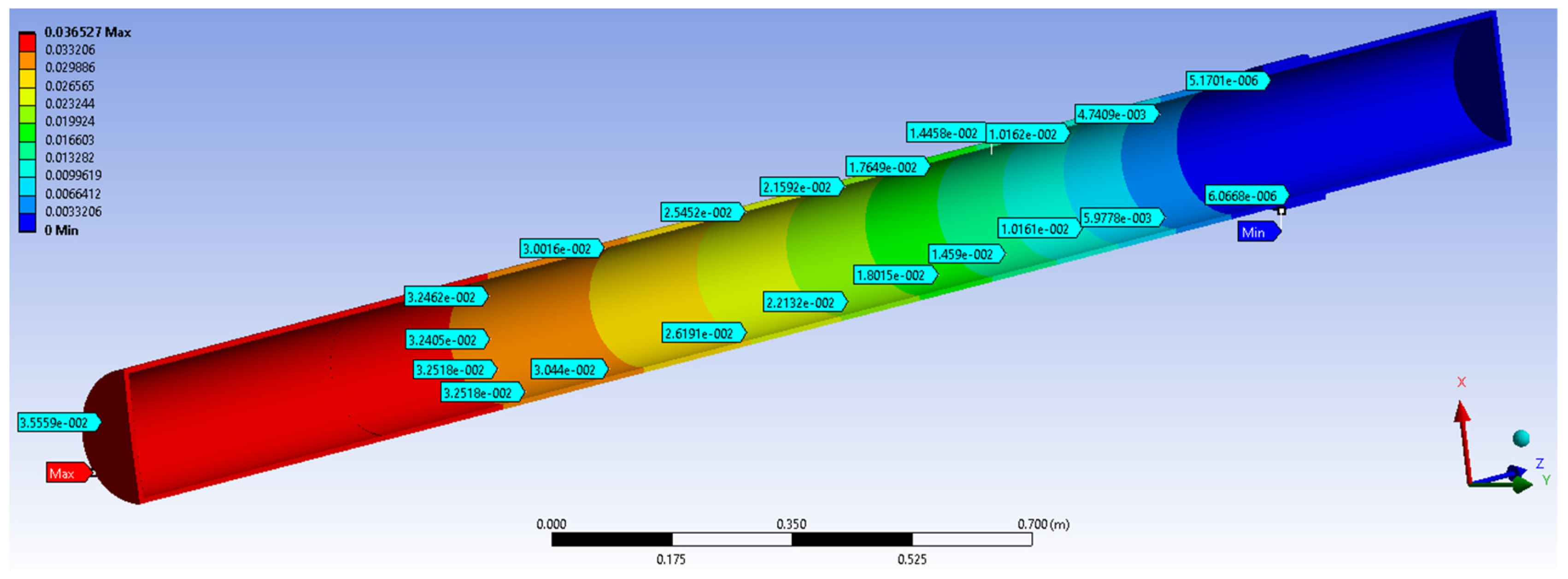
| Nominal Diameter DN (mm) | Wall thickness t (mm) | Longitudinal Elasticity Module E (MPa) | Transversal Elasticity Module G (MPa) | Poisson’s Coefficient (μ) | Specific Weight (kN/m3) | Yield Point (MPa) | |
|---|---|---|---|---|---|---|---|
| GRP250 | 250 | 6.2 | 18,000 | 3300 | 0.29 | 9.5 | 25 |
| Scenario | Target Lateral Displacement DL (mm) | Force DL (N) | Coefficient of Correlation R2 | The Maximum Angle of Rotation (°) |
|---|---|---|---|---|
| CG500 | 20.02 | 175.41 | 0.7043 | 1.239 |
| CA500 | 20.20 | 250.15 | 0.9947 | 1.489 |
| Object Name | 500/Solid1 | FLEXSEAL200/ Solid1 | 2500/Solid1 | FLUSH MOUNTING/Solid1 | PLUGS/Solid1 | PLUGS/Solid1 |
|---|---|---|---|---|---|---|
| Material | ||||||
| Assignment | GRP | EPDM RUBBER | GRP | Stainless Steel | GRP | GRP |
| Nonlinear Effects | Yes | |||||
| Thermal Strain Effects | Yes | |||||
| Bounding Box | ||||||
| Length X [m] | 0.2 | 0.215 | 0.2 | 0.215 | 0.2 | |
| Length Y [m] | 0.2 | 0.215 | 0.2 | 0.215 | 0.2 | |
| Length Z [m] | 0.5 | 0.15 | 2.5 | 0.1 | 0.01 | |
| Properties | ||||||
| Volume [m³] | 2.2677 × 10−3 | 7.333 × 10−4 | 1.1338 × 10−2 | 4.8886 × 10−4 | 3.1415 × 10−4 | |
| Mass [kg] | 2.1724 | 0.7333 | 10.862 | 3.7887 | 2.4346 | 0.30095 |
| Centroid X [m] | 4.7849 × 10−2 | |||||
| Centroid Y [m] | 2.1864 × 10−2 | |||||
| Centroid Z [m] | 0.25 | 0.515 | 1.78 | 2.58 | −5 × 10−3 | 3.035 |
| Moment of Inertia Ip1 [kg·m²] | 5.5261 × 102 | 5.3203 × 10−3 | 5.679 | 2.3545 × 10−2 | 6.0958 × 10−3 | 7.5351 × 10−4 |
| Moment of Inertia Ip2 [kg·m²] | 5.5261 × 10−2 | 5.3203 × 10−3 | 5.679 | 2.3545 × 10−2 | 6.0958 × 10−3 | 7.5351 × 10−4 |
| Moment of Inertia Ip3 [kg·m²] | 2.0096 × 10−2 | 7.8919 × 10−3 | 9.9769 × 10−2 | 4.0777 × 10−2 | 1.2151 × 10−2 | 1.502 × 10−3 |
| Statistics | ||||||
| Nodes | 16.088 | 5376 | 79.384 | 3808 | 440 | 454 |
| Elements | 2408 | 728 | 12,040 | 504 | 56 | 58 |
| Mesh Metric | Aspect ratio 4.23:1.54 | |||||
| Skewness Min. 3.5714 × 10−2/Max 0.62935/Average 0.35623 | ||||||
| Mesh Type | Hexa-core cell type | |||||
| Part Tolerance: | 0.00000001 | |||||
| Models | ||
|---|---|---|
| Viscous model | k-epsilon | |
| k-Epsilon model | standard | |
| Near-wall treatment | standard wall function | |
| (UAV) | Boundary Conditions | |
| Inlet | Pressure Far-field | |
| Gauge pressure | 2 Bars | |
| Turbulent intensity | 0.9999999776483% | |
| Hydraulic diameter | 0.5 m | |
| Outlet | Pressure outlet | |
| Walls | ||
| Wall motion | stationary wall | |
| Solution Methods | ||
| Pressure-coupling | SIMPLE | |
| Spatial discretization | Pressure | standard |
| Momentum | first-order upwind | |
| Turbulent kinetic energy | first-order upwind | |
| Turbulent dissipation rate | first-order upwind | |
| Initialization | ||
| Initialization method | Standard | |
| Gauge pressure | 2 Bars | |
| Velocity (x,y,z) | (0,0,0) m/s | |
| Turbulent kinetic energy | 0.135 m2/s2 | |
| Turbulent dissipation rate | 0.0465741 m2/s3 | |
| Force (N) | Target Lateral Displacement, DL (mm) | |
|---|---|---|
| Experimental Value | Value Obtained with MEF | |
| 250 | 20.22 | 23.687 |
| Measured Points | Horizontal Lateral Displacement | |
|---|---|---|
| Flexible Junction System GA500 (mm) | System without Flexible Junction (mm) | |
| 1 | 23.687 | 35.116 |
| 2 | 23.875 | 35.113 |
| 3 | 23.740 | 33.090 |
Publisher’s Note: MDPI stays neutral with regard to jurisdictional claims in published maps and institutional affiliations. |
© 2021 by the authors. Licensee MDPI, Basel, Switzerland. This article is an open access article distributed under the terms and conditions of the Creative Commons Attribution (CC BY) license (https://creativecommons.org/licenses/by/4.0/).
Share and Cite
Ancaș, A.D.; Așchilean, I.; Profire, M.; Țurcanu, F.E.; Felseghi, R.-A. Experimental Study on the Behaviour of Seismic Actions on a Flexible Glass-Reinforced Plastic Structure Used in Water Transport Pipes. Materials 2021, 14, 2878. https://doi.org/10.3390/ma14112878
Ancaș AD, Așchilean I, Profire M, Țurcanu FE, Felseghi R-A. Experimental Study on the Behaviour of Seismic Actions on a Flexible Glass-Reinforced Plastic Structure Used in Water Transport Pipes. Materials. 2021; 14(11):2878. https://doi.org/10.3390/ma14112878
Chicago/Turabian StyleAncaș, Ana Diana, Ioan Așchilean, Mihai Profire, Florin Emilian Țurcanu, and Raluca-Andreea Felseghi. 2021. "Experimental Study on the Behaviour of Seismic Actions on a Flexible Glass-Reinforced Plastic Structure Used in Water Transport Pipes" Materials 14, no. 11: 2878. https://doi.org/10.3390/ma14112878
APA StyleAncaș, A. D., Așchilean, I., Profire, M., Țurcanu, F. E., & Felseghi, R.-A. (2021). Experimental Study on the Behaviour of Seismic Actions on a Flexible Glass-Reinforced Plastic Structure Used in Water Transport Pipes. Materials, 14(11), 2878. https://doi.org/10.3390/ma14112878








